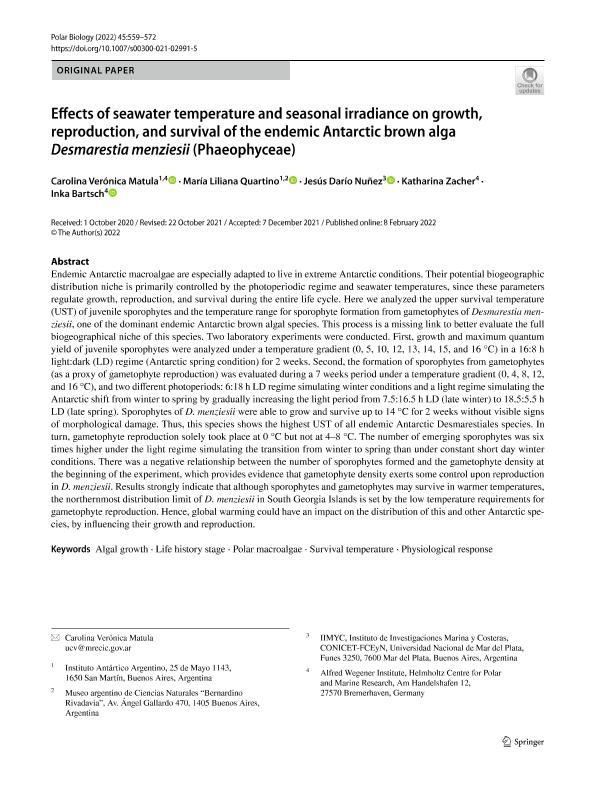Mostrar el registro sencillo del ítem
dc.contributor.author
Matula, Carolina Veronica

dc.contributor.author
Quartino, Maria Liliana

dc.contributor.author
Nuñez, Jesus Dario

dc.contributor.author
Zacher, Katharina
dc.contributor.author
Bartsch, Inka
dc.date.available
2023-07-14T14:40:03Z
dc.date.issued
2022-02-08
dc.identifier.citation
Matula, Carolina Veronica; Quartino, Maria Liliana; Nuñez, Jesus Dario; Zacher, Katharina; Bartsch, Inka; Effects of seawater temperature and seasonal irradiance on growth, reproduction, and survival of the endemic Antarctic brown alga Desmarestia menziesii (Phaeophyceae); Springer; Polar Biology; 45; 4; 8-2-2022; 559-572
dc.identifier.issn
0722-4060
dc.identifier.uri
http://hdl.handle.net/11336/203968
dc.description.abstract
Endemic Antarctic macroalgae are especially adapted to live in extreme Antarctic conditions. Their potential biogeographic distribution niche is primarily controlled by the photoperiodic regime and seawater temperatures, since these parameters regulate growth, reproduction, and survival during the entire life cycle. Here we analyzed the upper survival temperature (UST) of juvenile sporophytes and the temperature range for sporophyte formation from gametophytes of Desmarestia menziesii, one of the dominant endemic Antarctic brown algal species. This process is a missing link to better evaluate the full biogeographical niche of this species. Two laboratory experiments were conducted. First, growth and maximum quantum yield of juvenile sporophytes were analyzed under a temperature gradient (0, 5, 10, 12, 13, 14, 15, and 16 °C) in a 16:8 h light:dark (LD) regime (Antarctic spring condition) for 2 weeks. Second, the formation of sporophytes from gametophytes (as a proxy of gametophyte reproduction) was evaluated during a 7 weeks period under a temperature gradient (0, 4, 8, 12, and 16 °C), and two different photoperiods: 6:18 h LD regime simulating winter conditions and a light regime simulating the Antarctic shift from winter to spring by gradually increasing the light period from 7.5:16.5 h LD (late winter) to 18.5:5.5 h LD (late spring). Sporophytes of D. menziesii were able to grow and survive up to 14 °C for 2 weeks without visible signs of morphological damage. Thus, this species shows the highest UST of all endemic Antarctic Desmarestiales species. In turn, gametophyte reproduction solely took place at 0 °C but not at 4–8 °C. The number of emerging sporophytes was six times higher under the light regime simulating the transition from winter to spring than under constant short day winter conditions. There was a negative relationship between the number of sporophytes formed and the gametophyte density at the beginning of the experiment, which provides evidence that gametophyte density exerts some control upon reproduction in D. menziesii. Results strongly indicate that although sporophytes and gametophytes may survive in warmer temperatures, the northernmost distribution limit of D. menziesii in South Georgia Islands is set by the low temperature requirements for gametophyte reproduction. Hence, global warming could have an impact on the distribution of this and other Antarctic species, by influencing their growth and reproduction.
dc.format
application/pdf
dc.language.iso
eng
dc.publisher
Springer

dc.rights
info:eu-repo/semantics/openAccess
dc.rights.uri
https://creativecommons.org/licenses/by/2.5/ar/
dc.subject
Algal growth
dc.subject
Life history stage
dc.subject
Polar macroalgae
dc.subject
Survival temperature
dc.subject
Physiological response
dc.subject.classification
Conservación de la Biodiversidad

dc.subject.classification
Ciencias Biológicas

dc.subject.classification
CIENCIAS NATURALES Y EXACTAS

dc.title
Effects of seawater temperature and seasonal irradiance on growth, reproduction, and survival of the endemic Antarctic brown alga Desmarestia menziesii (Phaeophyceae)
dc.type
info:eu-repo/semantics/article
dc.type
info:ar-repo/semantics/artículo
dc.type
info:eu-repo/semantics/publishedVersion
dc.date.updated
2023-07-06T22:17:50Z
dc.journal.volume
45
dc.journal.number
4
dc.journal.pagination
559-572
dc.journal.pais
Alemania

dc.journal.ciudad
Berlin
dc.description.fil
Fil: Matula, Carolina Veronica. Ministerio de Relaciones Exteriores, Comercio Interno y Culto. Dirección Nacional del Antártico. Instituto Antártico Argentino; Argentina
dc.description.fil
Fil: Quartino, Maria Liliana. Ministerio de Relaciones Exteriores, Comercio Interno y Culto. Dirección Nacional del Antártico. Instituto Antártico Argentino; Argentina. Consejo Nacional de Investigaciones Científicas y Técnicas. Oficina de Coordinación Administrativa Parque Centenario. Museo Argentino de Ciencias Naturales "Bernardino Rivadavia". Estación Hidrobiológica de Puerto Quequén (sede Quequén); Argentina
dc.description.fil
Fil: Nuñez, Jesus Dario. Consejo Nacional de Investigaciones Científicas y Técnicas. Centro Científico Tecnológico Conicet - Mar del Plata. Instituto de Investigaciones Marinas y Costeras. Universidad Nacional de Mar del Plata. Facultad de Ciencias Exactas y Naturales. Instituto de Investigaciones Marinas y Costeras; Argentina
dc.description.fil
Fil: Zacher, Katharina. Alfred-Wegener-Institut, Helmholtz-Zentrum für Polar- und Meeresforschung; Alemania
dc.description.fil
Fil: Bartsch, Inka. Alfred-Wegener-Institut, Helmholtz-Zentrum für Polar- und Meeresforschung; Alemania
dc.journal.title
Polar Biology

dc.relation.alternativeid
info:eu-repo/semantics/altIdentifier/url/https://link.springer.com/10.1007/s00300-021-02991-5
dc.relation.alternativeid
info:eu-repo/semantics/altIdentifier/doi/http://dx.doi.org/10.1007/s00300-021-02991-5
Archivos asociados
